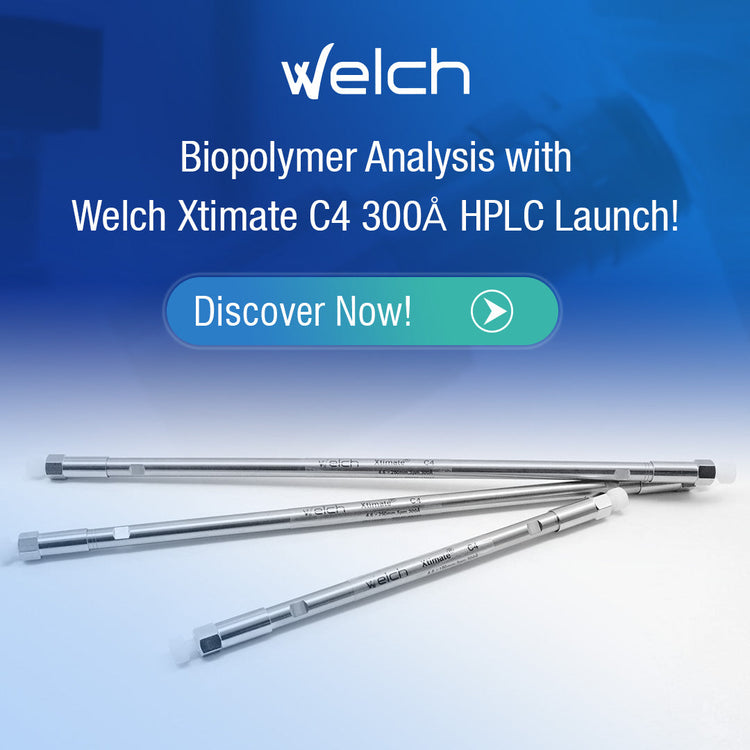
In 2023, the United States FDA approved a total of 55 new drugs for market release, among which biologic macromolecule drugs (including monoclonal antibody drugs, small nucleic acid drugs, and peptide drugs) accounted for 23, making up 42% of the total. This demonstrates the sustained fervor in the field of biopharmaceuticals.

Reverse-phase chromatography, one of the most widely used tools in the arsenal of chromatographers, is favored for its high sensitivity, versatility, and excellent separation capabilities. It is extensively employed in the analysis of biologic macromolecules such as proteins. In the selection guide for reverse-phase columns, typically, the larger the molecular weight, the shorter the alkyl chain used, and it is recommended to use columns with larger pore sizes.
Welch Materials has recently introduced the Xtimate® C4 300Å chromatography column, which offers typical reverse-phase separation and features high column efficiency, long lifespan, and wide pH tolerance. It is ideal for the analysis of biologic macromolecules.

Product Introduction
The Xtimate® series features high-purity silica-based matrix surface bonded with organic-inorganic hybrid layers, representing the continuous innovative research and breakthroughs in surface modification technology by Welch Materials' R&D team. This unique combination endows the product with both the high column efficiency and mechanical strength characteristic of silica-based matrices, as well as the high pH tolerance typically associated with polymer fillers. It is an almost perfect, high-quality HPLC chromatography column product that represents the current international leading level.
Product Highlights
pH range extended to 1.0-12.5.
Available in both 5μm and 3μm silica microsphere fillers.
Excellent stability for high pH applications.
Performance Parameters
- Bonding Phase: C4
- Carbon Load: 4%
- Pore Size: 300Å
- Particle Size: 5μm/3μm
- Specific Surface Area: 100m2/g
- pH Stability: 1.0-12.5
- Maximum Tolerable Temperature: 60℃
- USP Number: L26

Application Case
Application Case 1: Multi-Protein Determination
HPLC Conditions:
-
Column:
- Xtimate® C4, 3μm, 300Å, 4.6*150mm
- Xtimate® C4, 5μm, 300Å, 4.6*150mm
-
Mobile Phase:
- A: 0.1% TFA Water
- B: 0.1% TFA Acetonitrile
Detection Wavelength: 220nm
Column Temperature: 60℃
Flow Rate: 1.0mL/min
Injection Volume: 10μL
-
Injection Concentration:
- Ribonuclease (0.2mg/mL)
- Cytochrome C (0.2mg/mL)
- Lysozyme (0.2mg/mL)
- α-Lactalbumin (0.2mg/mL)
- Catalase (0.2mg/mL)
- Carbonic Anhydrase (0.2mg/mL)
Gradient elution procedure:
| Time/min | A % | B % |
| 0.0 | 85 | 15 |
| 15.0 | 50 | 50 |
| 15.1 | 5 | 95 |
| 18.0 | 5 | 95 |
| 18.1 | 85 | 15 |
| 27.0 | 85 | 15 |
Xtimate ® C4,3μm,300Å,4.6*150mm

Xtimate ® C4,5μm,300Å,4.6*150mm


Application Case 2: Determination of Human Erythropoietin
Chromatographic Conditions and Gradient Elution Program: Same as in Case 1.
Sample Preparation: Accurately weigh 1.0mg of human erythropoietin reference standard, add 1.0mL of water, dissolve, shake well, and it is ready for use.
Xtimate ® C4,3μm,300Å,4.6*150mm

Xtimate ® C4,5μm,300Å,4.6*150mm

Application Case 3: Determination of Lactoferrin
Chromatographic Conditions and Gradient Elution Program: Same as in Case 1.
Sample Preparation: Accurately weigh 1.0mg of lactoferrin reference standard, add 1.0mL of water, dissolve, shake well, and it is ready for use.
Xtimate ® C4,3μm,300Å,4.6*150mm
Xtimate ® C4,5μm,300Å,4.6*150mm
Conclusion:
The use of Xtimate® C4 300Å HPLC column for protein sample analysis provides excellent separation capability and good peak shapes, meeting the detection requirements.
The availability of two particle size specifications contributes to protein sample analysis.

